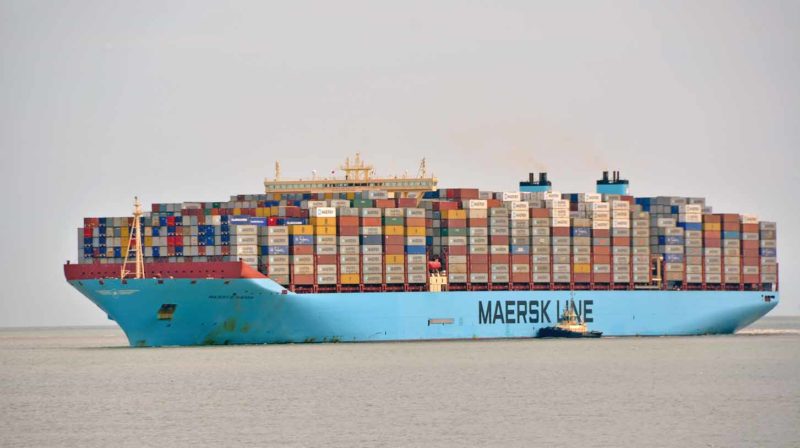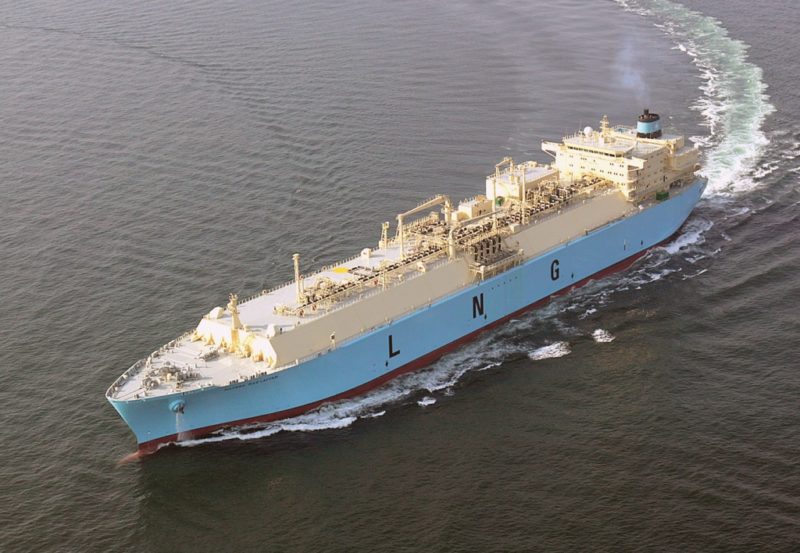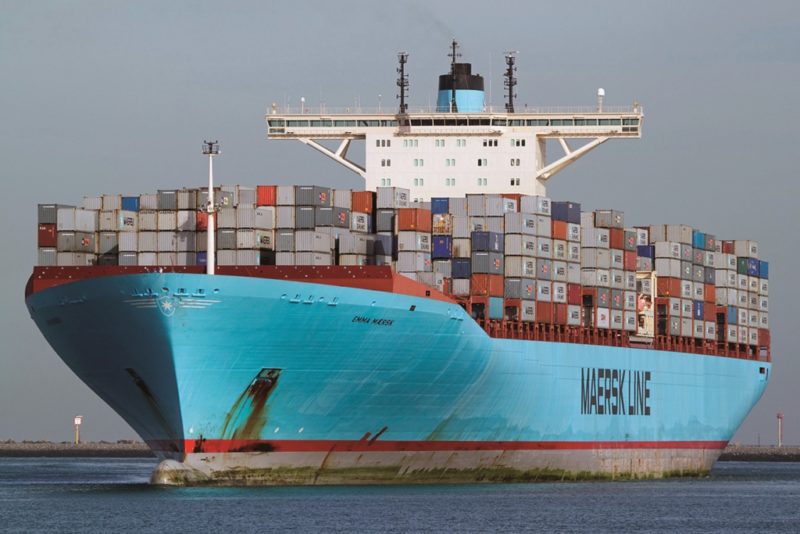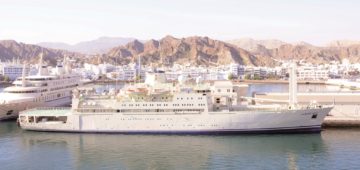
The merged A. P. Møller-Mærsk A/S was formed in June 2003 on the merger of D/S Svendborg A/S and D/S af 1912 A/S, with Group services then as follows:-
- EUROPE TO PERSIAN GULF AND INDIAN SUBCONTINENT – Weekly service designated AE3
- FAR EAST TO MIDDLE EAST AND MEDITERRANEAN – Weekly service designated AE4
- U.S.A. TO FAR EAST – Seven weekly services, five from the West Coast and one from the East Coast via the Panama Canal, and the seventh operated from the Eastern Seaboard via the Suez Canal
- ROUND THE WORLD – In conjunction with the above, and offering weekly Transatlantic services from the U.S.A. to Northern Europe and also from the U.S.A. to the Mediterranean
- WEST AFRICA – Weekly dedicated feeder services to and from Algeciras
- SOUTH AFRICA – Six new container ships were ordered for delivery in 2004/05 to replace the four ‘Big Whites’ of Safmarine on the joint SAECS service with P. & O. Nedlloyd and DAL of Germany. The Europe to South Africa service was then served by the new Group ships Lars Mærsk, Safmarine Nomazwe and Safmarine Nokwanda, with two new ships for P. & O. Nedlloyd and one for DAL of Germany
- CENTRAL AND SOUTH AMERICA – Weekly dedicated feeder services to the U.S.A. East and West coasts
- AUSTRALASIA – Three feeder services to Singapore and Japan from Australia and New Zealand
- INTRA-ASIA and INTRA-EUROPE – Extensive feeder services to connect with all of the above.

The large LNG carrier Mærsk Ras Laffan was delivered on 27th April 2004 from a South Korean yard for Qatar Shipping Ltd. in which Mærsk had a 25% interest. Apart from a similar interest in the earlier LNG Challenger in 1974 with P. & O., this was their first entry into the new expanding LNG market, with the port of Ras Laffan in Qatar set to be the main shipment point for the bulk of future LNG supplies. A sister was delivered as Mærsk Qatar in 2006 from the same Samsung yard at Keoje Island in South Korea, and five slightly larger sisters followed in 2008.
The Group Financial Report for the centenary year of 2004 showed that profits from container shipping had more than doubled to $1.5 billion with total profit at $3.2 billion as against $2.2 billion in2003. However, the Group shipbuilding business lost money, as did the Mærsk airline Mærsk Air. Tankers and offshore operations produced a result considerably above that of 2003. The Danske Bank with a 20%Group shareholding was now regarded as a Group subsidiary. APM TERMINALS and MæRSK LOGISTICS, both agencies of Mærsk-SeaLand, showed a big improvement in profits, while the sale of Mærsk IT boosted these excellent results. The Mærsk Board of Directors issued a dividend of Dkr 450 per share as against Dkr 300 per share in the previous year. The Mærsk-SeaLand fleet was now 300 owned and chartered ships of 12.0 million dwt, and the Møller-Mærsk tanker fleet was one hundred tankers of 17.0 million dwt.

APM TERMINALS is the Ports Division of the Group with headquarters in The Hague, and controls four European hub terminals of Hamburg, Bremerhaven, Rotterdam and Antwerp, as well as the former Sea-Land terminals at Boston, Houston, New York, Port Everglades, Tacoma, Jacksonville and New Orleans. In addition, over 50 more ports have Mærsk container activity and are organised into 17 geographic areas supported by a central Copenhagen office to complete the worldwide network. The total owned, leased and chartered fleet uses a container box stock of one million TEU boxes. The Mærsk order book was also equally impressive, consisting of over 70 container ships of which two dozen are of over 100,000 dwt, 30 tankers including 5 new LNG carriers for delivery in 2008, 3 vehicle carriers and several tugs for Svitzer Marine. The Safmarine fleet consisted of 40 container and general cargo ships, both owned and chartered, on SAECS (South Africa to Europe Container Service) as well as West African and Far East services from South Africa. The Sea-Land fleet also consisted of 40 container ships in 2004, many owned by American Banks and on routes across the world.
An offer of €56 per share on 10th May 2005 for all of the shares of Royal P. & O. Nedlloyd was accepted by the Anglo-Dutch company in a cash offer of €2.3 billion. Thus, Mærsk at number 1 in the container industry with 22% of world capacity took over number 3 to give Møller-Mærsk a capacity of 1.304 million TEU and maintain its preferred lead of over twice the capacity of its nearest competitor in MSC (Mediterranean Shipping Company) at 0.674 million TEU. The new workforce of the Danish, British and Dutch combine was 33,000 with 1,500 jobs lost in P. & O.Nedlloyd offices. The deal also included Reederei Blue Star, the wholly owned KG German company that had ships on long lease to P. & O.Nedlloyd. P. & O. made a book profit of £181 million on the deal for their 25% holding i.e. proceeds of£396 million less the cost of their share of the fleet at £215 million. Knud Stubkjaer, Chief Executive of Mærsk-Sealand, and Tommy Thomsen, Chief Executive of Mærsk Tankers, had played prominent parts in the takeover talks. The deal was ratified on 11th August 2005 after Mærsk had acquired 96.5% of P. & O.Nedlloyd shares.

The Group name in 2006 on container ships became MæRSK LINE instead of MæRSK-SEALAND, and P. & O. Nedlloyd withdrew from the Grand Alliance grouping to the Far East, and there were also ‘knock on’ changes to the South African and other consortia. Mærsk Air was sold to undisclosed buyers on30th June 2005 in the same month that Clementine Mærsk rescued 27 refugees to the south of Sicily and landed them at the Trinity Terminal in Felixstowe. The Group policy of rescue is in the best traditions of saving life at sea.
Crown Prince Mary of Denmark launched the ‘Super Post Panamax’ container ship Gudrun Mærsk of 9,000 TEU capacity at Odense on 7th May 2005, in a ceremony also attended by Mærsk McKinney Møller. A week later, the semi-retired, but still in overall control, former Chief Executive was in Le Havre to visit port officials and representatives of Terminaux de Normandie, which he last visited at the Frenchport in 1936. He was in Le Havre to discuss an ongoing dispute regarding the status of container gantry crane operators at the port, with 220 employees preferring to be employed directly by Le Havre Port Authority. APM Terminals had two gantries in the port, with CMA CGM of France using the remaining pair after they were completed.

Subscribe today to read the full article!
Simply click below to subscribe and not only read the full article instantly, but gain unparalleled access to the specialist magazine for shipping enthusiasts.




Comments
Sorry, comments are closed for this item